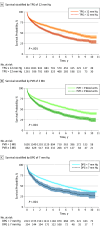Association Between Hemodynamic Markers of Pulmonary Hypertension and Outcomes in Heart Failure With Preserved Ejection Fraction
- PMID: 29541759
- PMCID: PMC5875307
- DOI: 10.1001/jamacardio.2018.0128
Association Between Hemodynamic Markers of Pulmonary Hypertension and Outcomes in Heart Failure With Preserved Ejection Fraction
Erratum in
-
Error in Axis Label in Figures.JAMA Cardiol. 2018 Jul 1;3(7):665. doi: 10.1001/jamacardio.2018.1559. JAMA Cardiol. 2018. PMID: 29847612 Free PMC article. No abstract available.
Abstract
Importance: Heart failure with preserved ejection fraction (HFpEF) is highly prevalent, yet there are no specific therapies, possibly due to phenotypic heterogeneity. The development of pulmonary hypertension (PH) in patients with HFpEF is considered a high-risk phenotype in need of targeted therapies, but there have been limited hemodynamic and outcomes data.
Objective: To identify the hemodynamic characteristics and outcomes of PH-HFpEF.
Design, setting, and participants: Cohort study of participants who had a right heart catheterization from January 2005 to September 2012 (median [interquartile range] follow-up time, 1578 [554-2513] days) were analyzed. Hemodynamic catheterization data was linked to the clinical data repository of all inpatient and outpatient encounters across a health system. Single tertiary referral center for heart failure and PH within a large health care network using a common clinical data repository was studied. There were 19 262 procedures in 10 023 participants.
Exposures: Participants were classified as having no PH, precapillary PH, or PH in the setting of left heart disease (reduced or preserved ejection fraction). Pulmonary hypertension associated with HFpEF was defined as mean pulmonary artery pressure of 25 mm Hg or more, pulmonary artery wedge pressure of 15 mm Hg or more, and left ventricular ejection fraction of 45% or more. Pulmonary hypertension severity was quantified by the hemodynamic parameters transpulmonary gradient, pulmonary vascular resistance, and diastolic pulmonary gradient.
Main outcomes and measures: The primary outcome was time to all-cause mortality. Secondary outcomes were time to acute hospitalization and cardiovascular hospitalization.
Results: The mean (SD) of all study individuals was 65 (38) years. Of 10 023 individuals, 2587 (25.8%) had PH-HFpEF. Mortality was 23.6% at 1 year and 48.2% at 5 years. Cardiac hospitalizations occurred in 28.1% at 1 year and 47.4% at 5 years. The frequency of precapillary PH using clinically defined cut-offs for transpulmonary gradient (>12 mm Hg), pulmonary vascular resistance (3 Woods units), and diastolic pulmonary gradient (≥7 mm Hg) were 12.6%, 8.8%, and 3.5%, respectively. Transpulmonary gradient, pulmonary vascular resistance, and diastolic pressure gradient were predictive of mortality and cardiac hospitalizations.
Conclusions and relevance: In a large cohort referred for invasive hemodynamic assessment, PH-HFpEF was common. Transpulmonary gradient, pulmonary vascular resistance, and diastolic pulmonary gradient are all associated with mortality and cardiac hospitalizations.
Conflict of interest statement
Figures



Comment in
-
Population-Based Studies of Invasive Hemodynamics: A Glimpse Into the Future.JAMA Cardiol. 2018 Apr 1;3(4):306-307. doi: 10.1001/jamacardio.2018.0163. JAMA Cardiol. 2018. PMID: 29541741 No abstract available.
-
Left Ventricular Ejection Fraction Cut Point of 50% for Heart Failure With Preserved Ejection Fraction.JAMA Cardiol. 2018 Oct 1;3(10):1023. doi: 10.1001/jamacardio.2018.1906. JAMA Cardiol. 2018. PMID: 30027275 No abstract available.
-
Left Ventricular Ejection Fraction Cut Point of 50% for Heart Failure With Preserved Ejection Fraction-Reply.JAMA Cardiol. 2018 Oct 1;3(10):1023-1024. doi: 10.1001/jamacardio.2018.1936. JAMA Cardiol. 2018. PMID: 30027277 No abstract available.
Similar articles
-
Pulmonary vascular disease in the setting of heart failure with preserved ejection fraction.Trends Cardiovasc Med. 2019 May;29(4):207-217. doi: 10.1016/j.tcm.2018.08.005. Epub 2018 Aug 17. Trends Cardiovasc Med. 2019. PMID: 30177249 Free PMC article. Review.
-
Pulmonary hypertension is related to peripheral endothelial dysfunction in heart failure with preserved ejection fraction.Circ Heart Fail. 2014 Sep;7(5):791-8. doi: 10.1161/CIRCHEARTFAILURE.113.000942. Epub 2014 Jul 21. Circ Heart Fail. 2014. PMID: 25047042
-
Pulmonary Arterial Capacitance Is an Important Predictor of Mortality in Heart Failure With a Preserved Ejection Fraction.JACC Heart Fail. 2015 Jun;3(6):467-474. doi: 10.1016/j.jchf.2015.01.013. JACC Heart Fail. 2015. PMID: 26046840 Free PMC article.
-
Hemodynamic Phenotyping of Pulmonary Hypertension in Left Heart Failure.Circ Heart Fail. 2017 Sep;10(9):e004082. doi: 10.1161/CIRCHEARTFAILURE.117.004082. Circ Heart Fail. 2017. PMID: 28912263 Review.
-
Pulmonary hemodynamics in heart failure patients with reduced or preserved ejection fraction and pulmonary hypertension: Similarities and disparities.Am Heart J. 2017 Oct;192:120-127. doi: 10.1016/j.ahj.2017.06.006. Epub 2017 Jun 21. Am Heart J. 2017. PMID: 28938958
Cited by
-
Clinical-imaging-pathological correlation in pulmonary hypertension associated with left heart disease.Eur Respir Rev. 2024 Feb 28;33(171):230144. doi: 10.1183/16000617.0144-2023. Print 2024 Jan 31. Eur Respir Rev. 2024. PMID: 38417969 Free PMC article.
-
Pulmonary vascular disease in the setting of heart failure with preserved ejection fraction.Trends Cardiovasc Med. 2019 May;29(4):207-217. doi: 10.1016/j.tcm.2018.08.005. Epub 2018 Aug 17. Trends Cardiovasc Med. 2019. PMID: 30177249 Free PMC article. Review.
-
Elevated pre-transplant pulmonary vascular resistance is associated with early post-transplant atrial fibrillation and mortality.ESC Heart Fail. 2020 Feb;7(1):176-187. doi: 10.1002/ehf2.12549. ESC Heart Fail. 2020. PMID: 32197001 Free PMC article.
-
Pulmonary hypertension associated with left heart disease.Herz. 2023 Aug;48(4):266-273. doi: 10.1007/s00059-023-05189-z. Epub 2023 Jun 8. Herz. 2023. PMID: 37289211 Review. English.
-
Relaxin mimetic in pulmonary hypertension associated with left heart disease: Design and rationale of Re-PHIRE.ESC Heart Fail. 2025 Jun;12(3):1956-1964. doi: 10.1002/ehf2.15203. Epub 2025 Jan 20. ESC Heart Fail. 2025. PMID: 39829393 Free PMC article.
References
-
- Go AS, Mozaffarian D, Roger VL, et al. ; American Heart Association Statistics Committee and Stroke Statistics Subcommittee . Executive summary: heart disease and stroke statistics: 2013 update: a report from the American Heart Association. Circulation. 2013;127(1):143-152. - PubMed
-
- Redfield MM, Jacobsen SJ, Burnett JC Jr, Mahoney DW, Bailey KR, Rodeheffer RJ. Burden of systolic and diastolic ventricular dysfunction in the community: appreciating the scope of the heart failure epidemic. JAMA. 2003;289(2):194-202. - PubMed
-
- Bursi F, Weston SA, Redfield MM, et al. . Systolic and diastolic heart failure in the community. JAMA. 2006;296(18):2209-2216. - PubMed
-
- Gerges C, Gerges M, Lang MB, et al. . Diastolic pulmonary vascular pressure gradient: a predictor of prognosis in “out-of-proportion” pulmonary hypertension. Chest. 2013;143(3):758-766. - PubMed
Publication types
MeSH terms
Substances
Grants and funding
LinkOut - more resources
Full Text Sources
Other Literature Sources
Medical

